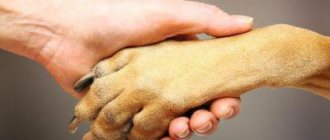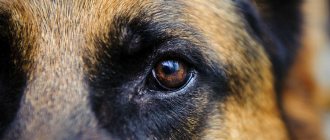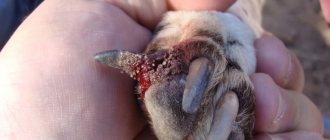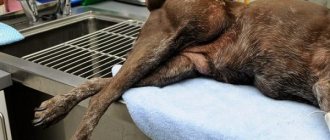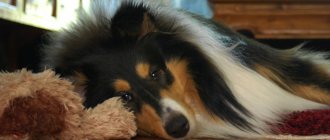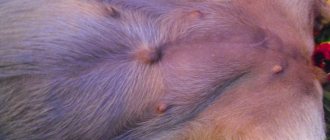Features of the structure of a dog's paw
Normally, a dog's paw consists of four toes with soft pads and claws. The pads have a shock-absorbing function, they reduce the load when running and walking. Their skin is rough, which provides the animal with stability on slippery surfaces. In working dogs, due to prolonged exposure to fresh air, the surface of the pads becomes rough.
Dewclaws in dogs – pathology or normal
When walking, the main load falls on the dog's fingers. They cannot move them because the space between the fingers is too small.
Depending on the shape of the paw there can be three types:
- Felines are distinguished by their compact size and round shape. These paw shapes are typical for dogs of large breeds, for example, Spanish mastiff and husky.
- Hare feet are elongated, with long ring fingers. This structure allows you to quickly develop speed.
- Webbed - this shape is typical for hunting dogs, for example, the Jack Russell Terrier.
Dewclaws in puppies raise many questions among owners.
Structure of a dog's paw
What do these fingers do?
The presence of dewclaws in a dog is not considered something abnormal or pathological. This is a completely acceptable phenomenon, and for some breeds, this is one of the signs that determines the purity of their origin, the level of thoroughbred. These are such well-known four-legged breeds as the Gyrenees dog and the Beauceron. In any case, no external or obvious deviations were found in breeds with a fifth toe.
Personal experience
For ardent hunters, the presence of dewclaws is only an aesthetic problem and nothing more. They don’t pay attention to this and it’s completely in vain, because such atavisms on the paws create serious obstacles for a hunting dog when walking and running, especially in forests, tall grass, thickets, and reeds. Protruding and slightly spreading to the side, the fifth toes cling very strongly to the spruce forest, twigs, mud, snow and other natural obstacles, which ultimately cause serious and rather painful injuries to the dog. While hunting, sometimes for several days, hunters do not immediately notice the resulting injuries, which have already become inflamed. Depending on weather conditions and the season, this process varies in intensity. Such wounds are a serious obstacle that limits the dog’s movement, and as a result, if the matter takes a serious turn, this can put an end to the entire hunt.
Reasons for the appearance of an extra finger
Dog Wheelchair for Hind Limbs
The appearance of an extra toe on a dog's paw is called atavism. This phenomenon means that the animal's body contains characteristics of all the species that were involved in breeding. The fifth rudiment is a sign left over from a close blood ancestor; it indicates a connection with the wolf.
For your information! Most hunting breeds were crossed with wolves, hence the origin of the fifth toes. For certain breeds this is a natural phenomenon.
Scientists still cannot answer why in one and the same breed one puppy has a dewclaw, and the second does not. This is a dominant trait: if a male has five fingers and a female has four, then the puppies from such a marriage will have five fingers. This phenomenon is most often observed in German Shepherds.
An additional vestige indicates a connection with wolves
Could there be as many as six of them?
There are situations when puppies have two dewclaws at once. The owner must decide for himself whether they need to be removed. Everything will depend on whether they interfere with the animal.
Dog breeds in which dewclaws are not considered a defect
Pedigree: food for dogs and puppies of small and large breeds
The fifth claw in sporting dogs, as well as in show breeds, is considered a big drawback. The Jagdterrier or dachshund will be removed from the exhibition, and sporting dogs will not be allowed to compete. Such a claw itself interferes with regular grooming. For small dogs such as Spitz, Yorkie, Terrier or Chihuahua, an extra toe will be a big nuisance.
Important! Before removing an extra toe, you should consult a veterinarian. There are a number of breeds for which the dewclaw is a sign of purebred. These breeds include: French Shepherd, German Laika, Briard and Pyrenees.
Is it necessary to fight wolf claw in dogs?
Since dewclaws in dogs are not pathological, their removal is not necessary. Veterinarians may recommend surgery to avoid possible complications:
- injury to the puppy’s paw when running and walking;
- inconvenience during hygiene procedures, cutting, combing, washing your pet;
- ingrown nails into the skin.
Experts recommend removal without fail if the pet develops paw diseases. These include:
- tissue death - necrosis;
- gangrene of the paw;
- osteosarcoma.
Removal is also carried out if the dog has a serious injury to the dewclaw.
There are two groups of dogs that require mandatory surgery:
- Hunting, due to the extra shoot, it is very difficult for such an animal to move in forests and through thickets. The finger will constantly cling to branches and bushes and get damaged on the grass. This not only slows down the hunting process, but also causes pain to the animal.
- Show breeds: in this case, the removal of the rudiment is carried out in puppies.
Important! Veterinarians recommend removing dewclaws from puppies before seven days of birth. During this period, they will not feel severe pain, and the recovery process itself will pass quickly and without complications.
The removal procedure is performed using surgery. The recommended age is up to seven days, but operations are also performed on older dogs. Small puppies are given local anesthesia and sutures are placed, which subsequently dissolve on their own.
Removal surgery in dogs over 12 weeks of age is performed under general anesthesia.
If removal is not performed before the age of one week, then the operation can only be performed when the dog is more than 12 weeks old. This should only be done by an experienced veterinarian under general anesthesia.
After cutting, a recovery period is necessary. The dog is given a soft bandage on the damaged area. It is important to ensure that the dog does not tear off the stitches while licking the wound.
How does amputation occur?
Some dog owners, instead of seeking professional help, carry out the amputation themselves. But it would seem that the simplest operation can only harm the puppy: the owner will simply remove the rudiment incorrectly and in adulthood the pet will have to resort to removing the dewclaw again. If amputation is carried out without pain relief, the puppy will develop pain shock and the animal may die. Also, the puppy may develop an allergic reaction to the anesthesia; due to swelling of the larynx, the pet may die.
Veterinarians recommend removing the fifth toe in puppies when the risk of complications is minimal. A one-week-old puppy has a weak pain threshold, so amputation of the dewclaw is easier to tolerate than in adult dogs. The operation is performed under local anesthesia or general anesthesia, depending on the age of the pet. Surgical intervention is easily tolerated and does not pose a threat to the life of the animal. In adult dogs, the rudiment is removed after injury.
Fixation of the patient
Before amputation of the rudiment begins, the veterinarian fixes the animal. The method of immobilization depends on the age of the dog:
- A puppy up to a week of age is fixed by the owner. The breeder simply holds the pet tightly in his arms.
- An adult dog is immobilized on the operating table. The doctor selects the most comfortable position: on the left side or abdominal position.
If the animal is poorly secured, then during the removal of the rudiment, the veterinarian may involuntarily inflict a cut wound with a scalpel.
Anesthesia
The anesthesia procedure is selected for dogs depending on their age:
- Puppy. If the pet is less than a week old, the veterinarian will administer local anesthesia. The puppy is first injected with novocaine using the infiltration method.
- Adult dog. For adult dogs, amputation of the fifth toe is performed under general anesthesia.
Read Vaccination of a Laika puppy: vaccination table for up to one year
If the puppy did not have time to remove the rudiment before the age of one week, then the operation is postponed. In this case, the veterinarian will resort to surgical intervention when the dog reaches 12-16 weeks.
Progress of the operation
Removal of the 5th toe in puppies is carried out in a veterinary clinic where sanitary standards are observed. Before removing the vestige, the operating room is disinfected and instruments are sterilized. The course of the operation depends on the attachment of the rudiment:
- If the rudiment is attached to the skin, the veterinarian removes it using scissors and a scalpel.
- If the rudiment is connected to the bone by a phalanx, then the veterinarian will remove the second phalanx with a scalpel.
After the operation, the puppy may notice some bleeding. After stopping, the dog is given stitches and a sterile bandage. To prevent the puppy from developing stress, the doctor can sew the wound with self-absorbable threads - catgut.
Interesting! The operation to remove the rudiment is considered an easy manipulation. And the whole procedure lasts no more than 20 minutes.
Main causes of toe fractures in dogs
An extra claw on the hind paw most often interferes with the animal. It is mobile because it is not held together by cartilage and muscles. Because of this, injury often occurs. The dog cannot retract such a claw; he constantly clings to sticks, branches, bushes, and foliage. If the pet is active, this physiological phenomenon causes him a lot of inconvenience. Therefore, it is recommended to remove the extra finger.
It is not uncommon for dogs to break their appendix for various reasons. Often injuries occur due to the fault of the owners themselves. For example, a heavy object was dropped on the dog’s paw or stepped on, or pinched by a door. Most often, small breed dogs suffer from this.
Injuries that result in finger fractures occur in overly active pets. This is especially true for young puppies who actively run around in nature. They can get caught on a bush, fall into a hole, or get their paw caught between the roots. When you try to pull it out, your finger may turn, which will lead to a fracture.
Finger fractures cause severe pain to your pet
Dogs often suffer fractures during play or fighting due to bites. Even when just playing, dogs can bite each other's paws, which can lead to fractures.
Number of toes in dogs
How many toes do dogs have on their front paws ? In short, many dogs have five of them on their front legs (four of them are next to each other, as if formed, and the fifth is slightly higher). There are usually 4 on the hind legs. But the number of toes can vary. Some people, when asked how many toes dogs have on their front paws , answer 4 or 5.
How many toes do dogs have on their hind paws ? Things are more difficult with the hind legs. The fact is that often instead of the usual 4 toes, dogs have 5 on their hind legs. The fifth in this situation is called a dewclaw or wolf’s claw. If a dog has a dewclaw on its hind leg, then it is called atavism - a kind of greeting from the distant past. It is believed that dogs rarely develop a fifth toe as a memory of the previous generation - wolves, who needed it for hunting. But among animals it was the strongest. In dogs, the dewclaw is often poorly developed, sticking out to the side, with a large curved claw. That is, the newcomer often interferes with the pet.
Moreover, an extra toe on the hind limbs interferes with the dog’s movement, and it looks even unsightly. This is why owners of show breeds prefer to remove wolf claws a couple of days after birth. Domestic dogs usually have it removed on their hind legs only if necessary if it bothers them.
So, the number of toes a dog has on its hind legs is clear: four or five. What to do with the fifth toe on the forelimbs? This finger does not take part in running, as it is located high, next to the wrist. The fact is that it helps the dog hold toys or bones. It certainly cannot be called unnecessary. Therefore, dewclaws are rarely removed when they make it difficult to trim or comb the paws.
Caring for your dog's dewclaws
If the owner does not plan to remove the excess growth on the pet’s paw, it is necessary to provide it with proper care. It is necessary to trim the claw regularly. When visiting the groomer, you need to indicate that the dog has a fifth claw, so that the specialist does not accidentally cause damage. You need to constantly check your finger, as it is injured more often than others.
A dewclaw is not a pathology, but it can cause inconvenience and discomfort to your pet. Therefore, each owner must decide for himself whether removal surgery is required or not.
